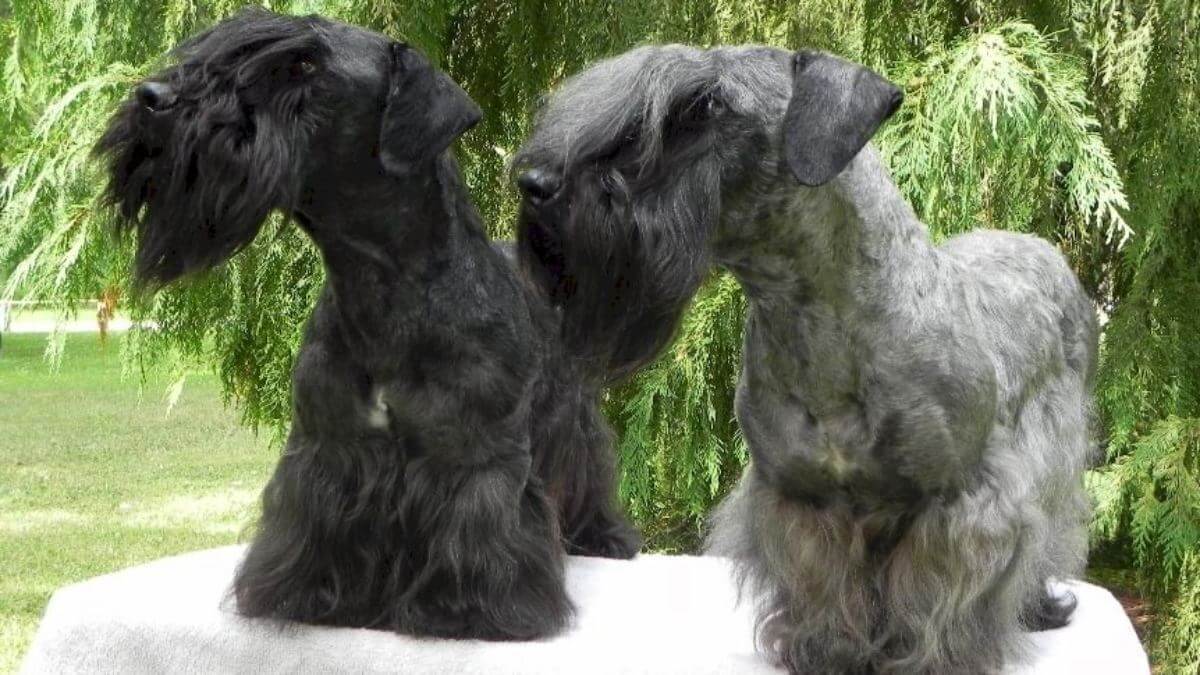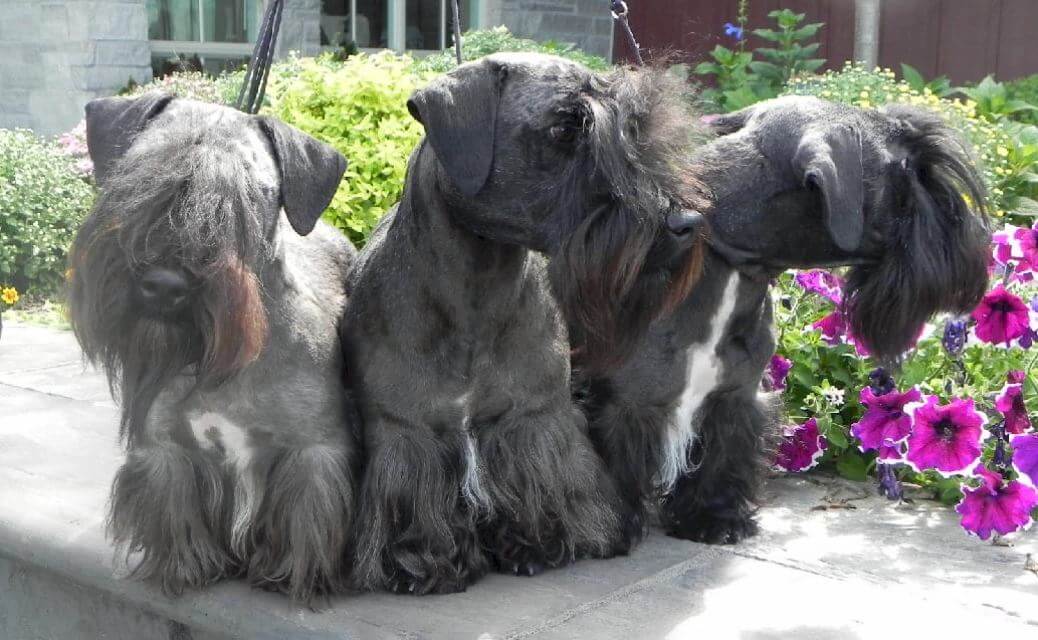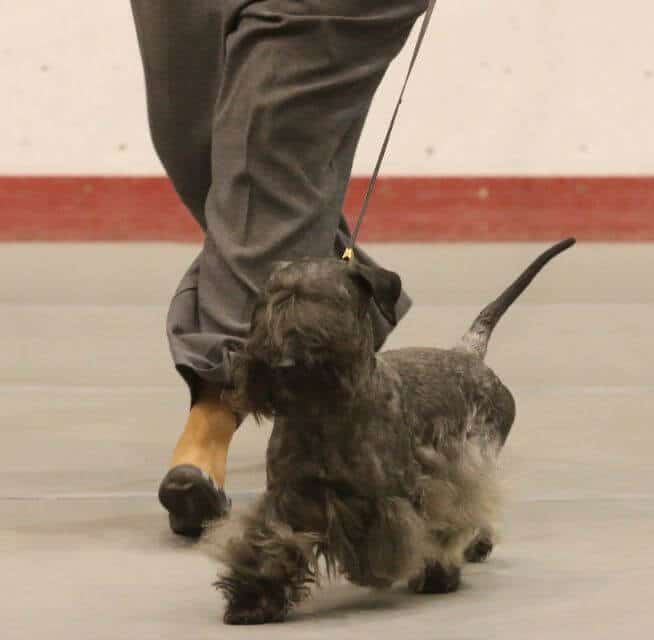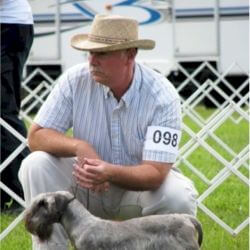
Home » Judging the Cesky Terrier

This article was originally published in Showsight Magazine, August 2013 issue.
The Cesky Terrier has had a long and arduous trail to AKC group-four recognition, garnering many enthusiasts along the way. Unique in color as well as conformation, the breed is not altogether different from many of its terrier companions in the group—something to be emphasized when judging. This plucky terrier from the Czech Republic has been recognized the world over for many years. Soft-coat, long in body, and un-level topline begin the featured list of the breed, characteristics prevalent in many terriers that we’ve known for decades. This breed’s general appearance is of a small, sturdy, agile dog with keen expression and temperament.
Developed for pack hunting, the Cesky Terrier will go-to-ground after rabbits, badgers or foxes as well as give chase and catch prey above ground. Oblong in shape, it was designed to be narrower than the Sealyham to get into tighter warrens, and the coat pigment allows for a much more practical hunting terrier. Today the breed makes for a wonderful family pet. Its soft, wavy coat is easily maintained. The Cesky Terrier is a well-balanced breed, with features best described by moderate, slight, and gradual terms. Cesky Terriers come in two colors; grey is the most common, with brown/coffee so rare that only a handful of examples have been known to exist in the breed’s history.
Young dogs going through coat color changes (greys are born black and fade to grey by two years of age) may show a brown cast to their coats which clears as dogs mature. Grey colors range from platinum to charcoal and everything in between, with no preference whatsoever. Many Cesky Terriers have quite acceptable white markings (blaze on chest, white toes); however, the white should not exceed 20% of the coat coloring. Brindling can occur but should be penalized. Brindle is often hard to recognize because the coat fades from black to some level of grey. Dark coats make the brindling easier to see, but as the coat fades, so do the markings. With other brindled breeds, coloring is often bi-colored (black on red, black on fawn, etc.), but brindling on the Cesky Terrier is evident as grey on grey; dark and light striping is evident when you know what to look for.

The topline is a very identifiable trait of the Cesky Terrier that needs close attention. The topline should be a gradual rise, starting in the loin and rising up to the rump. In a correct topline, the highest point of the profile after the withers should be the rump. When the rise happens too quickly, it will give a roached appearance and the topline will fall mid-hip. This is not in keeping with the Breed Standard and should most definitely be discouraged. Many feel that because the topline is not level, a “roached” back is correct; this is not an acceptable profile for the breed. Tails are carried relatively low. I say “relatively” because they do not have the spinal configuration of a Bedlington (where the spine drops off well before the tail) but have a configuration more like a Dandie Dinmont or Border Terrier (where the tail is a continuation of the spinal outline).
When excited, a Cesky Terrier can bring its tail up relatively high for such a low set, but over-the-back carriage is indicative of a bad tail-set and perhaps of a questionable topline. When relaxed, the Cesky Terrier will drop its tail, which is part of the breed’s character. It should not be tucked; hanging completely down is acceptable. When moving, they will bring the tail up, anywhere from a very slight rise all the way to almost perpendicular. Judges in the terrier ring tend to favor exhibits with higher tail carriage as showing “true terrier” temperament. The measure of a Cesky Terrier’s temperament should not be the position of its tail, unless, of course, the tail is tucked. Although the standard does not emphasize this, the Cesky Terrier is a true working terrier. They were built for go-to-ground work as well as for chasing down prey above ground. They should be very well-muscled dogs, and the angulations of their front and rear should reflect this.
They are sprinters; their oblong shape, well-muscled shoulder and rump allow them to move with ease in an effortless stride. Movement should be somewhat parallel since the chest is deep but rests between the forelegs and does not interfere with leg movement. The ribcage is oval in shape, not rounded. Fronts are relatively straight, elbows resting along the sides of the ribcage. With the shortness of leg, forearms angle in only slightly from elbow to pastern. The stride of this terrier should exhibit purpose; it is not a “walking” terrier. Seasoned exhibitors know to give themselves some room on the go-around to allow the dogs to move out. Bear in mind, these dogs are bred to bolt after rabbits and foxes; they should show the reach and drive to do so.

With respect to the head, think of a blunt wedge: not-too-broad skull tapering slightly to muzzle. Cheeks should be moderate, able to palpate but not protruding. Eyes are dark and almond-shaped. Ears are set on high, with fold on the same level as the top of the skull, not protruding above the skull. They are triangular in shape with the forward edge of the ear staying close to the cheek—not flaring out or hanging away from the head, from top to bottom. Ears are moderately sized and should not hang below the cheek. Large, pendulous ears should be faulted. Planes of the skull are not quite parallel and should show a slight but obvious stop.
The temperament of the Cesky Terrier, according to the standard, is noted to be “reserved.” They are curious about their surroundings yet wary of strangers. Unlike other breeds in the group who are all too happy to see a new face, the Cesky Terrier does not exude this behavior. Often aloof, they should never be shy and should, by all means, stand for exam. When judging, if you show bait to a Cesky Terrier, it most likely will show significant interest. Most will do anything for food! Keep in mind that the Cesky Terrier was developed to hunt in packs, something that was difficult if not impossible for terriers with more “fight” in them – like the Scottie. This is NOT a sparring breed; in this regard, they are more similar to Bedlington and Border Terriers.
This wonderful Czech breed, with all of the differences and similarities to many of AKC’s well-established terrier breeds, is enjoying a great deal of attention since entering the AKC Terrier Group in June of 2011. Understanding aspects of this “new kid on the block” is important for both judge and ringside observers as well as this breed’s exhibitors, owners and breeders. It has been a long road getting here; the work is just beginning as we create an awareness of the finer points of this beautiful Bohemian breed of terrier.

